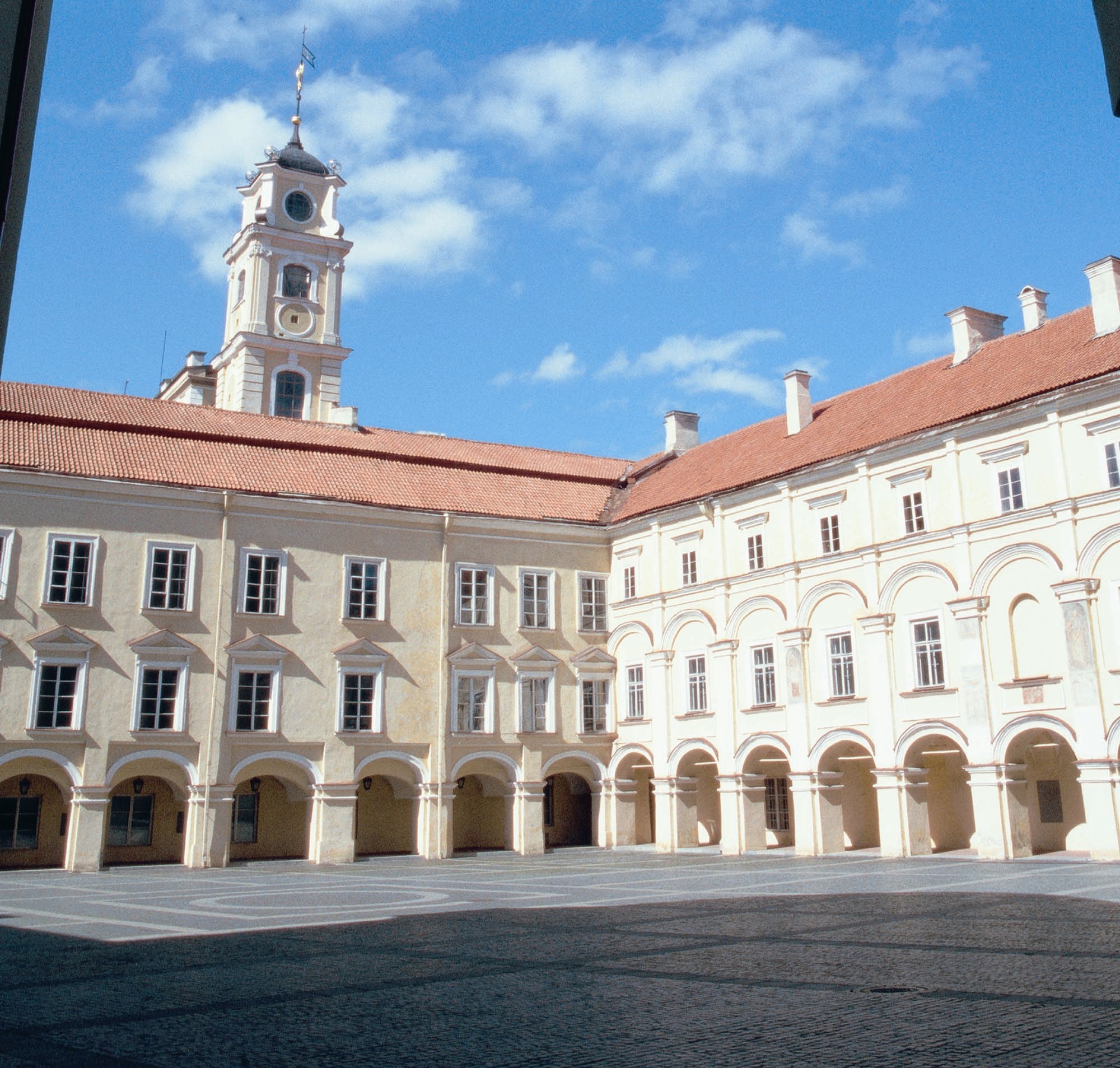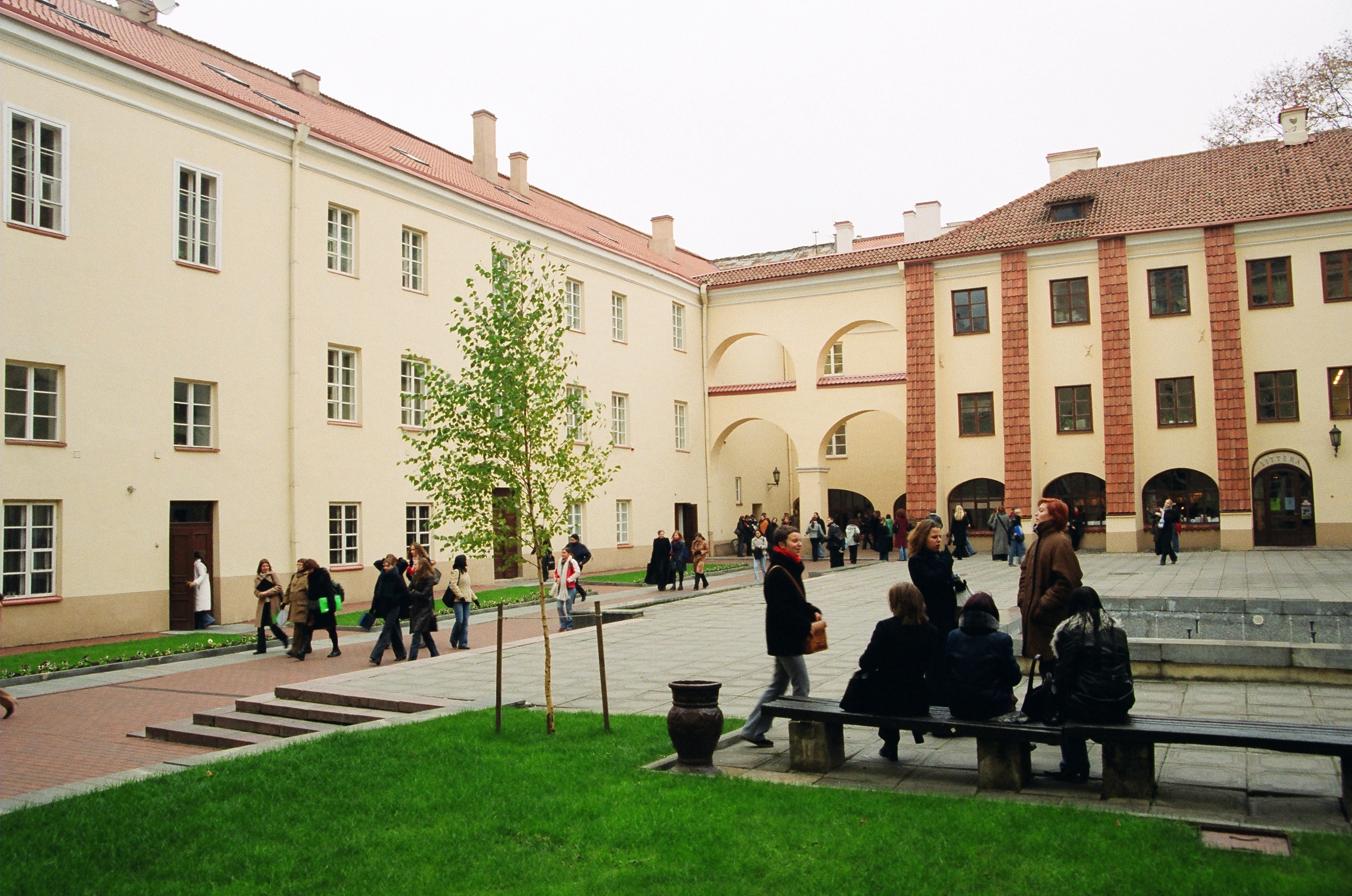Conference Venue: Vilnius University
Conference venue:
Faculty of Philology
Universiteto St. 5, Vilnius
University in the City

1. Central buildings (Rector’s Office, Library, Faculties of History, Philology, Philosophy, and History, Institute of Foreign languages).
2. Institute of International Relations and Political Sciences.
3. Faculties of Medicine and Natural Sciences.
4. Faculties of Mathematics and Informatics, and Chemistry.
5. Faculties of Economics, Physics, Law,Communication, Institute of Applied Research.
Pictures
Exteriors
Interiors
© 1997—2011 Vilnius University
Vilnius University
The University of Vilnius was founded in the 16th century under the influence of ideas of the Renaissance, Reformation and Counter-Reformation. It can be considered one of the oldest universities in Central and Eastern Europe. Only the universities of Prague, Kraków, Pécs, Budapest, Bratislava and Königsberg were older.
Key dates in the history of Vilnius University:
1569 - the Jesuits came to Vilnius and founded the Vilnius Jesuit College in 1570.
1579 - on April 1, Stephanus Bathoreus, King of Poland and Grand Duke of Lithuania, issued a Charter opening Academia et Universitas Vilnensis Societatis Jesu and on October 30, Pope Gregory XIII issued a papal bull confirming the status of a university. At the beginning there were two faculties - the Faculty of Philosophy and the Faculty of Theology.
1991 - the University of Vilnius joined the Great Charter of European Universities.
Many famous scholars worked at the University: the famous medical men from Vienna Johann Peter Frank and his son Joseph Frank, the historian and public figure Joachim Lelewel, the poets Adam Mickiewicz and Juliusz Slowacki, historian Simonas Daukantas, etc.
- Among the Academy graduates who wrote verse in Latin Mathias Casimir Sarbievius (1578-1640) was known throughout Europe.
- Two famous medical men from Vienna, Johann Peter Frank (1745-1821) and his son Joseph (1771-1842), were invited to Vilnius University by the Rector in 1804.
- The Observatory was established on the initiative of the astronomer and mathematician Tomas Zebrauskas(1714-1758) and support of benefactress E. Oginskaitė-Puzinienė. The Observatory attained its fame under the auspices of its former director Marcin Odlianicki Poczobut(1728-1810), the member of London Royal and Sorbonne Academies, rector of Vilnius University(1780-1799).
Today the University has 12 faculties, 8institutes, 6 interdisciplinary study and research centres, 3 university hospitals. Over 24 thousand students study at the University.
The old campus of Vilnius University

1. Grand Courtyard
2. Observatory Courtyard
3. Library Courtyard
4. M. K. Sarbievijus Courtyard
5. M. Daukša Courtyard
6. S. Daukantas Courtyard
7. Arcade Courtyard
8. L. Gucevičius Courtyard
9. A. Mickevičius Courtyard
10. S. Stanevičius Courtyard
11. K. Sirvydas Courtyard
12. Printing House Courtyard
13. Bursary Courtyard
Currently the old University campus consists of 13 courtyards and 13 buildings which have several sections each, as well as Sts. Johns' Church and its belfry.

The Grand Courtyard is enclosed on three sides by open arched galleries and the façade of Sts Johns' Church. It is the most magnificent courtyard in the whole ensemble. The oldest buildings are the northern and western wings. The frescoes decorating the pilasters of the Grand Courtyard portray the founders of the Academy in the northern wing and the kings of Poland and Lithuania in the western wing. The memorial plaques in the ground floorgallery commemorate the most famous professors and alumni of the University.
The Observatory Courtyard is dominated by the Observatory Building with an extension in Classical style decorated by afrieze with the signs of Zodiac. Several memorial plaques can be seen on the wall of the extension. At the top one can see a quotation from Virgil: ‘Courage illuminated the old world with new light'. Below is another inscription: This house belongs to Urania: down with petty troubles! The contemptible earth is disdained here; from here the way leads to the stars'. The memorial tablet is dedicated to commemorate the150th anniversary of the Educational Commission - the first prototype of the Ministry of Education in Europe.

The Mathias Casimirus Sarbievius Courtyard houses the Faculty of Philology, one of the largest of the twelve Faculties of the University. At the time of the Jesuit Academy, these buildings provided service facilities, one wing contained stables and a brewery. In the early 19th century the northern building was altered and converted into an apartment house for professors. Professor of the Department of Architecture used the interior décor of his apartment as visual aids to teach his students the intricacies of architectural details.
Mathias Casimirus Sarbievius, whose name was given to the courtyard, was an alumnus and later professor of Vilnius Academy, a preacher at Sts. Johns' Church, famous all over Western Europe for his lyrics celebrating the beauty of Lithuanian nature, especially the beauty of the countryside around Vilnius. He was awarded a laurel wreath by Pope Urban VIII and named ‘the Horace of Sarmatia'.
The Bookshop ‘Littera'
Thebookshop was decorated with original paintings by Antanas Kmieliauskas.Frescoes cover almost the whole vaulted area. In eight segments symbolic figures of astronomy, medicine, botany, music, art, printing and other sciences and arts flourishing at Vilnius University are depicted. Above the pillars forming the vaults you can see portraits of famous University professors, alumni and patrons.
The Library Courtyard
Themain entrances to the old University campus and the Main Building are from the Library Courtyard. The courtyard acquired its present shape of an open space in the early 19th century after the western wing was pulled down. The most attractive in this courtyard is the Main Building with a tower of the former Observatory and Baroque windows decorated with astronomical and mathematical instruments and adorned with signs of the seven major planets. The entrance to the Library is decorated by a monumental door, sculptured by Jonas Meškelevičius, to commemorate the 450th anniversary of the first Lithuanian book. The only surviving copy of Martinus Mosvidius Catechismus in Lithuania, published in Königsberg in 1547, is kept at the University library. The Library is famous for its magnificent old interior design because not many such interiors havesurvived in secular buildings in Vilnius.
The Mikalojus Daukša Courtyard, which houses the Faculty of History, is named after the author of the first Lithuanian book published in Vilnius in the late 16th century. A copy of Mikalojus Daukša's Katekizmas (Catechism), published by the Vilnius academy printing house, is kept at the Library of Vilnius University. During thetimes of the Jesuit Academy, the northern and eastern one-storey structures were used for stables and a coach-house. After the reconstruction in the late 18th century, the western wing was altered to contain quite a few apartments for professors.
The Simonas Daukantas Courtyard
The author of the first history of Lithuania in the Lithuanian language wanted to study at the University so much that he forged his documents, proclaimed himself a representative of the gentry, left his native Samogitia and came to Vilnius on foot. The oak tree in the middle of the courtyard was brought from his native Klevai village. The southern wing, decorated with a Renaissance attic, is one of the older surviving buildings in the courtyard.
The Arcade Courtyard
Thebuildings surrounding the courtyard were acquired by the University in the late 18th century. Today they house the Institute of Foreign Languages and the departments and classrooms of the Faculty of Philology.
The Wawrzyniec Gucewicz Courtyard
Thefamous architect, the builder of the Vilnius Cathedral, Town Hall and Verkiai Palace, was professor of the University and Head of the department of Architecture. A memorial plaque with Wawrzyniec Gucewicz' relief (sculptor Konstantinas Bogdanas) to commemorate the famous architect was put on the wall of the northern wing. Today the courtyard houses the Department of Scandinavian Languages, and the basement is occupied by the Student Underground Theatre.
The Adam Mickiewicz Courtyard
Thepresent view of the courtyard was formed after the reconstructions in the second half of the 19th century when all the buildings were put under one roof. Adam Mickiewicz was one of the most renowned alumni of Vilnius University, who made the name of Lithuania and Vilnius famous throughout Europe, and left a significant mark in the history of Vilnius University as well as the literary and cultural history of Europe. The years of studies, publication of his first poems, student societies, meetings of Philomats, and imprisonment - all this happened at Vilnius University.
Since the 18th century the Theatre Hall of the Jesuit Academy, well equipped for performances, was known to be on the second floor in the Grand Courtyard. In 1804, according to the design of the architect Michal Szulc the Hall was converted into three auditoria for lectures and experiments in physics. After the closing of the University, the Theatre Hall was altered to serve as an Orthodox Church of the Gymnasium. Then a balcony on wooden pillars and a wooden ceiling were added. Today it belongs to the student theatre, conferencesand seminars are also held there.

The Small Aula was rebuilt after a fire in the 18th century by Ioannes Glaubicius. At the time of the Jesuit Academy, it was used as a hall of ceremonies. In the early 19th century, it was adapted for a library according to the designby Michal Szulc.

Sts. Johns' Church is one of the oldest churches in Vilnius. Its construction started in 1387 as soon as Lithuania adopted Christianity. The Jesuit Order used it as an auditorium for sermons, public debates and theatrical ceremonies. The Church suffered from many wars and fires, was rebuilt and repaired. It acquired its present magnificent appearance representing the late Baroque after the fire of 1737 when it was reconstructed by Ionnes Christophorus Glaubicius, the founder of the unique school of Lithuanian Baroque. The Church became really magnificent, its vaults were decorated with frescoes, and there were 22 altars in the central nave, abundantly decorated chapels and an organ. In the early 19th century, the interior of the Church was changed, most Baroque decorations were taken down, altars were pulled down, and the frescoes were covered with white paint. In this Church the author of the first trilingual Lithuanian-Polish-Latin dictionary, Constantinus Syrvidus gave his sermons in Lithuanian, later a famous Polish composer Stanislaw Moniuszko played the organ. Today the Church is used not only for religious service, but also for concerts, meetings of the Senate and for conferring academic degrees.























